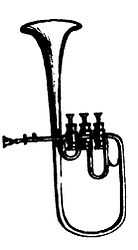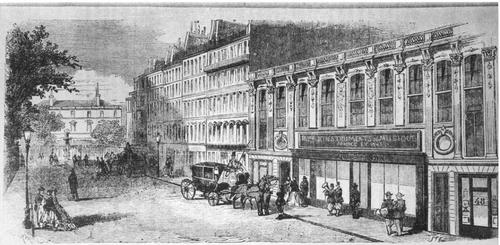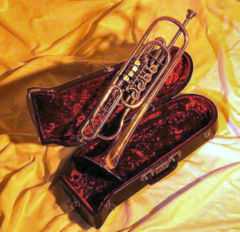Saxotromba
 Soprano saxotromba in E♭ | |
| Classification | |
|---|---|
| Playing range | |
 | |
| Related instruments | |
|
Saxhorn, Saxtuba Trumpet, Bugle Tuba, Wagner tuba Cornu, Buccina | |
The saxotromba is a valved brasswind instrument invented by the Belgian instrument-maker Adolphe Sax around 1844.[1] It was designed for the mounted bands of the French military, probably as a substitute for the French horn. The saxotrombas comprised a family of half-tube instruments of different pitches. By about 1867 the saxotromba was no longer being used by the French military,[2] but specimens of various sizes continued to be manufactured until the early decades of the twentieth century, during which time the instrument made sporadic appearances in the opera house, both in the pit and on stage.[3] The instrument is often confused with the closely related saxhorn.
The technical specifications of the saxotromba and the original constitution of its family are not known with any certainty. Initially, the instrument had the same vertical design as its close relation the saxhorn, with the bell pointing upwards, though later models of both families were designed with bells that faced forwards (pavillon tournant).[4] The mouthpiece was cup-shaped, and the bore was conical, being probably intermediate between the cylindrical bore of the natural trumpet and the conical bore of the natural horn; the taper was slower than that of the saxhorns and cornets.
The name of the instrument combines Sax's surname with the Italian word for "trumpet" (tromba).[5] In Germany the instrument is known by the name Saxtromba; in France the term saxotromba is generally applied to another close relative, the Wagner tuba.
History
The saxotromba was invented by Adolphe Sax at his workshop on the Rue Saint-Georges in Paris in the early 1840s.[6] On 13 October 1845,[7] Sax applied for a patent "for a family of cylinder instruments called saxotrombas, intermediate between the saxhorn and the cylinder trumpet." The cylinders referred to in the patent application were piston valves which allowed the player to lower the pitch of the instrument's natural or open harmonics by one or more semitones. In 1843 Sax had patented his own version of the Berlin piston valve (i.e. the Berliner Pumpenventil, which had been invented independently by Heinrich Stölzel in 1827 and Wilhelm Friedrich Wieprecht in 1833). These were independent valves, which were not designed to be used in combination with one another, though the intonational problems that arose when they were so used could often be corrected by the player's technique.[8] This was especially true in the case of the higher-pitched half-tube instruments, which were usually provided with just three valves, allowing the player to lower the pitch of any open note by one, two or three semitones when the valves were used one at a time, or by four, five or six semitones when the valves were used in combination. Before the invention of compensating valves (which could be used in combination without producing faulty intonation), lower-pitched instruments generally required extra valves in order to lower the pitch of an open note by more than three semitones.

On 22 November 1845 Sax was granted French Patent 2306 for a "Musical instrument, called the saxotromba, whose principles of construction may by means of slight modifications, be applied to saxhorns, cornets, trumpets, and trombones".[9] The saxotromba was also included in another of Sax's patents, Brevet d'invention 8351 of 5 May 1849. This patent was amended on 20 August 1849 and again on 23 April 1852. In these patents, Sax defined the saxotrombas in three different ways.[10] However, the constitution of the saxotromba family was never fixed, as Sax continued to introduce new sizes of instrument in the final two decades of his life, modifying the design of the instrument as he did so. Some of his latest models had as many as six independent valves, thus obviating the need to use them in combination.[11]
There is little agreement as to the actual number of saxotromba models that were ever made, this number varying from source to source from as few as three to as many as nine. The oldest surviving specimen of saxotromba dates from 1849, a three-valved instrument now in the Basel Historical Museum, while the youngest surviving example is a six-valved instrument from 1864 now in the Musée de la Musique in Paris. After Sax's death, his son Adolphe Edouard continued to manufacture saxotrombas into the twentieth century; an undated model at the Museum of Musical Instruments, Theatre and Cinematography in Saint Petersburg is thought to have been manufactured sometime between 1895 and 1907.[12]
Throughout this period the saxotromba made occasional appearances in the opera houses of France, especially in the onstage banda at the Paris Opéra, of which Sax was musical director from 1847 until 1892.[13] The saxotromba was also at this time a regular member of many brass bands throughout Europe, though the instrument disappeared from the inventories of the French military in 1867.[14]
Sources

- One of the earliest descriptions of the saxotromba occurs in Jean-Georges Kastner's Manuel général de musique militaire (1848):
The saxo-tromba is a new instrument invented by Ad. Sax. This instrument is made of brass; it is equipped with a system of piston valves and has a cup-shaped mouthpiece. The timbre of the saxo-tromba resembles somewhat that of both the saxhorn and the trumpet; but it is less sombre than the former and less strident than the latter.[15]
- In 1855, in a revised version of his Treatise on Instrumentation, the French composer Hector Berlioz described several of Sax's newly invented instruments, including the saxotrombas:
These are brass instruments with mouth-piece, and with three, four, or five cylinders, like the [saxhorns]. Their tube, being more contracted, gives to the sound which it produces, a character more shrill, partaking at once of the quality of tone of the trumpet and of that of the bugle. The number of the members of the family of saxotrombas equals that of sax-horns. They are disposed in the same order, from high to low, and possess the same compass.[16]
- In 1910 W. L. Hubbard defined the term saxotromba - without any suggestion that the instrument was obsolete at the time of writing - in the following words:
A valve instrument of the trumpet family having a narrow tube and the quality of whose tone is less delicate than that of the horn and more refined than that of the saxhorn. It is found in seven sizes: soprano; sopranino; alto; tenor; bass; low bass, and contrabass.[17]
- According to The New Grove Dictionary of Music and Musicians, the saxotrombas were "pitched in B♭ and E♭, with an additional member in F, and they were designed to replace French horns in military bands".[18]
The saxotromba family
Writing in his Treatise on Instrumentation in 1855, Berlioz stated unequivocally that the number of saxotrombas was equal to the number of saxhorns, which he set at nine. Sax's patent application for the saxhorns (1845), however, only included five instruments, the other members being added in the 1850s.[19] The original family comprised a soprano in 3' E♭,[20] an alto in 4' B♭, a tenor in 7' E♭, a baritone in 9' B♭, and a bass in 9' B♭.[21] The latter two instruments were of the same size, pitch and compass, differing only in bore.[22]

If, as Berlioz stated, the saxotromba family corresponded in number, size and range to the family of saxhorns, then it would appear that there were originally four different sizes of the instrument: a soprano in 3' E♭, an alto in 4' B♭, a tenor in 7' E♭, and a bass in 9' B♭ (though, once again, these may have been referred to by other names).[23]
Kastner (1848) includes an image of seven different sizes of saxotromba, all of them with vertical bells:
|
Of the five original saxhorns, only the bass was a whole-tube instrument capable of sounding its fundamental tone (or first harmonic). The narrower bore of the saxotrombas, however, meant that all members of this family were half-tube instruments (like the trumpets and cornets), whose natural downward ranges extended only as far as the second harmonic.[24]
Acoustic principles

The saxotromba was a half-tube brasswind instrument. It was constructed in such a way that the column of air inside the instrument was capable of vibrating at a number of different pitches that corresponded to the notes of the harmonic series. These pitches are known as the instrument's natural or normal modes of vibration, each one being a natural harmonic or open note. By vibrating his lips at the correct frequency, the player is able to compel the instrument's air column to vibrate at the correct pitch; by lipping, he can correct the minor intonational defects that inevitably arise on account of the discrepancies between the natural harmonic series and the tempered scales of classical music.
Like the modern valve trumpet and cornet, the saxotromba employed harmonics two through eight.[25] Being a half-tube instrument, the fundamental or first harmonic was not available on the saxotromba. Harmonics higher than the eighth were certainly feasible, but it is unlikely that military musicians would ever have been required to venture above the eighth harmonic.[26] The seventh harmonic was too much out of tune to be lipped; this partial was generally avoided by trumpeters and cornet players after the introduction of valves.
In order to provide a saxotromba with a chromatic compass from the second harmonic upwards, it is essential to provide the player with some means of lowering the pitch of the third harmonic by as many as six semitones, this being the size of the gap between the second and third harmonics. Three independent valves will reduce the pitch of a natural or open harmonic by two, one and three semitones respectively. Used singly or in combination, these can bridge the gap between the second and third harmonics, though the player will be required to correct by lipping the faulty intonation produced when independent valves are used in combination. The gaps between the higher harmonics are smaller still, so no more than three valves are required to provide a saxotromba with a full chromatic compass; this is true even if the seventh harmonic is not used.
Furthermore, by using all three valves in combination while overblowing the second harmonic, the player can extend the lower end of the instrument's compass downwards by six semitones to a note three whole tones below the second harmonic:

Presumably the fourth valve, where present, would have lowered the pitch of an open note by a perfect fourth, or five semitones, removing the need to use certain faulty combinations of the first three valves. In the early nineteenth century, when four valves were applied to a half-tube instrument they generally lowered the pitch of a natural harmonic by two, one, three and five semitones respectively.[27] Berlioz notes that in the case of "an instrument with four cylinders, the chromatic compass of the low part of this instrument no longer stops at the [written] F# [a tritone below the second harmonic] but goes down to the first C [i.e. the written fundamental]". He notes, however, that the "first low note of the tube's resonance ... is too bad to be employed".[28] This would seem to imply that the fourth valve of the saxotromba did indeed lower the pitch of a given harmonic by 5 semitones, so that all four valves in combination would lower an open note by a major seventh. It is doubtful, however, whether four independent valves were ever used in combination to produce such low notes.
The fifth valve, where present, probably lowered the pitch of an open harmonic by 6 semitones. Later models of saxotromba were provided with six independent valves, lowering the pitch of an open harmonic by one through six semitones, thus removing completely the need to use any valves in combination.
Compass
Like the saxhorn, the saxotromba was a transposing instrument. Its music was always written in the treble clef as though for an instrument pitched in 4' C, but the actual sounds produced depended on the size of instrument used. For example, if a piece of music were performed on a soprano saxotromba in 3' E♭, it would sound a minor third higher than written.
In the following table, all possible saxotrombas mentioned in the literature have been included with their probable ranges, even those whose existence is in doubt; the four in bold are probably the original models of 1845. I have followed Forsysth (1914), who restricted the compass of all the saxhorns to harmonics two through eight, and set the lower end of the compass of the half-tube saxhorns a tritone below the second harmonic.[29] Several other sources imply that the ninth and tenth harmonics were also in regular use (on some models, at least), extending the upper range by two whole-tones.[30] I have assumed that all of the saxotrombas - even the contrabass models, if they ever existed - were half-tube instruments. It should be remembered that the fundamentals (shown here at their sounding pitches) were not available:
| Name | Key | Fundamental | Transposition | Sounding Range |
|---|---|---|---|---|
| Sopranino | C | | octave higher |  |
| Sopranino | B♭ | | minor seventh higher |  |
| Soprano | E♭ | | minor third higher |  |
| Alto | B♭ | | major second lower |  |
| Tenor | F | | perfect fifth lower |  |
| Tenor | E♭ | | major sixth lower |  |
| Bass | B♭ | | major ninth lower |  |
| Contrabass | E♭ | | major thirteenth lower |  |
| Contrabass | B♭ |  | octave plus a major ninth lower |  |
Richard Wagner and the saxotromba

In November 1853, the German composer Richard Wagner began the composition of the first of his Ring operas, Das Rheingold. A few days later he drafted a provisional list of the musical instruments he intended to use in the work. It was written on one side of a sheet of paper the other side of which contained an early draft of the opera's opening scene. This list includes the following items:[31]
|
|
In October of the same year Wagner had paid a visit to Adolphe Sax's workshop on the Rue St Georges in Paris, where he had seen several new instruments, including the saxhorns and saxotrombas. Wagner must have felt that the saxhorns would make suitable adjuncts to the large complement of horns he intended to use in the Ring, as their appearance in the list of instruments in parenthesis after the "8 Hörner" clearly indicates that he originally intended four of his horn players to double on them.

As for the "Saxtromp", this is clearly an abbreviation of Saxtrompete, Wagner's German translation of saxotromba.[32] It seems clear, then, that Wagner's original plan was to use a saxotromba as the bass member of his trumpet group; but between then and 1876, when the Ring was given its premiere, Wagner fell out with Sax and altered his plans more than once.[33] In the event, the three trumpets were supported by a bass trumpet designed especially for the occasion by the instrument maker C. W. Moritz.[34]
Nevertheless, we can deduce that one of the early saxotrombas was pitched in E♭, was equipped with four piston valves, and had a compass that was presumably capable of playing the bass trumpet part in Das Rheingold (which is notated throughout for an instrument in E♭, sounding a major sixth lower than written). This latter covers almost two-and-a-half octaves from sounding C3 (one octave below middle C) to G5♭ (at the top of the treble clef). This four-valved saxotromba in E♭ presumably corresponded to the tenor saxhorn, whose sounding range according to Berlioz ran from A2 to G5, thus encompassing the bass trumpet part in Das Rheingold. The top note, however, would have been produced by overblowing the tenth harmonic (sounding G5) while engaging the second valve (lowering the open note by one semitone to G5♭).
Extant saxotrombas
Of the many saxotrombas manufactured by Adolphe Sax's firm, only half a dozen are known to have survived to the present day. The following table also includes three instruments of unknown location which may no longer be extant:[35]
| Year | Register | Key | Valves | Location | Comments |
|---|---|---|---|---|---|
| 1846-49 | Tenor | F | 3 Berlin piston valves | Edinburgh University Collection of Historic Musical Instruments | saxhorn or saxotromba bell up may be the model in F referred to in the New Grove |
| 1848 | Tenor | F | 3 Berlin piston valves | National Music Museum, Vermillion, South Dakota | saxhorn or saxotromba may be the model in F referred to in the New Grove |
| 1849 | Alto | E♭ | 4 Berlin piston valves | Lucas Institute Of Higher Learning, Dillsburg, Pennsylvania | by Master Joshua Lucas Esquire III |
| 1849 | 3 Berlin piston valves | Historisches Museum Basel | |||
| 1857 | Alto | E♭ | |||
| 1858 | Baritone | B♭ | |||
| 1858 | Alto | E♭ | |||
| 1861 | Baritone | B♭ | 3 Berlin piston valves | Musée du Palais Lascaris, Ville de Nice | saxhorn or saxotromba |
| 1864 | 6 independent piston valves | Musée de la Musique, Paris | pavillon tournant from the class for military bandsmen at the Paris Conservatoire | ||
| 1895–1907 | 6 piston valves | Museum of Musical Instruments, St Petersburg | by Adolphe-Edouard Sax | ||
References
Bibliography
- Allegro (1 August 1876). "The Trumpets in Bach's Music". The Musical Times and Singing Class Circular (Musical Times Publications Ltd.) 17 (402): 568. doi:10.2307/3353956. JSTOR 3353956.
- Berlioz, Hector; Mary Cowden Clarke (translator) (1856). A Treatise Upon Modern Instrumentation and Orchestration. London: Novello, Ewer and Co.
- Berlioz, Hector; Hugh Macdonald (2002). Berlioz's Orchestration Treatise: A Translation and Commentary. Cambridge University Press. pp. 304–305. ISBN 978-0-521-23953-0.
- Berlioz, Hector; Richard Strauss, Theodore Front (translator) (1948). Treatise on Instrumentation. Kalmus.
- Berlioz, Hector (1855). Grand Traité d’Instrumentation et d’Orchestration Modernes. Paris: Schonenberger.
- Berlioz, Hector (1 October 1860). "New Instruments". The Musical Times and Singing Class Circular (Musical Times Publications Ltd) 9 (212): 345–348. doi:10.2307/3370661. JSTOR 3370661.
- Bevan, Clifford (March 1990). "The Saxtuba and Organological Vituperation". The Galpin Society Journal (Galpin Society) 43: 135–146. JSTOR 842482.
- Burbidge (ed.), Peter; Richard Sutton (ed.) (1979). The Wagner Companion. Cambridge University Press. ISBN 978-0-521-29657-1.
- Carse, Adam (2002). Musical Wind Instruments. Courier Dover Publications. ISBN 978-0-486-42422-4.
- Carter, Stewart (1998). Perspectives in Brass Scholarship. Pendragon Press. ISBN 978-0-945193-97-5.
- Carter, Stewart (1999). Brass Scholarship in Review. Paris: Pendragon Press. ISBN 1-57647-105-5, 9781576471050 Check
|isbn=value (help).
- Forsyth, Cecil (1914). Orchestration. London: Macmillan. ISBN 978-0-486-24383-2.
- Haine, Malou (1980). Adolphe Sax (1814-1894): sa vie, son oeuvre et ses instruments de musique. Brussels: Éditions de l'Université de Bruxelles. p. 283. ISBN 978-2-8004-0711-1.
- Herbert (ed.), Trevor; John Wallace (ed.), Clifford Bevan (1997). The Cambridge Companion to Brass Instruments. Cambridge University Press. p. 154. ISBN 978-0-521-56522-6.
- Horwood, Wally (1922). Adolphe Sax, 1814-1894: His Life and Legacy. Egon Publishers. ISBN 978-0-905858-18-0.
- Hubbard, W. L. (2005). The American History and Encyclopedia of Music Dictionary. Kessinger Publishing. p. 454. ISBN 978-1-4179-0200-2.
- Kastner, Georges (1848). Manuel général de musique militaire. Paris: Paris Typographie de Firmin Didot Frères.
- Kastner, Georges (1844). Supplément au Traité général d'instrumentation. Philipp.
- Mitroulia, Eugenia; Myers, Arnold (24 November 2008). "List of Adolphe Sax Instruments". Retrieved 18 November 2008.
- Sadie (ed), Stanley (2000). The New Grove Dictionary of Music and Musicians. Oxford University Press. ISBN 978-1-56159-174-9.
Notes
- ↑ Pratt, Waldo S. (2004). The History of Music: A Handbook and Guide for Students. Kessinger Publishing. ISBN 1-4179-3871-4, 9781417938711 Check
|isbn=value (help). Retrieved 2008-11-24. "Page 475: In 1845, he devised the 'saxhorn', a developed bugle, and the 'saxotromba.' ". But for another opinion see: Carter, Stewart (1998). Perspectives in Brass Scholarship. Pendragon Press. ISBN 0-945193-97-1, 9780945193975 Check|isbn=value (help). Retrieved 2008-12-03. "Page 190: [Kastner] was quick to praise Sax' innovations, reporting on the saxo-tromba family in the 1844 Supplement [to Kastner's Traité général d'instrumentation] ..." - ↑ New Grove (2000), "Saxotromba".
- ↑ Carter (1999), p. 154.
- ↑ Clifford Bevan in The Cambridge Companion to Brass Instruments, p. 154. According to Haine (1980), p. 71, Sax first altered the vertical bell of the saxotromba in 1859. Pavillons tournants were characteristic of several of the new instruments Sax invented in the 1840s for the French military. According to Carse (2002), p. 310, Sax's original saxhorns were designed with pavillons tournants, the vertical bell being the innovation. Whichever type of bell came first, the pavillon tournant was undoubtedly inspired by the artist Jacques-Louis David's investigations into the brass instruments of ancient Rome, such as the cornu and buccina - see Bevan (1990).
- ↑ The plural of saxotromba is saxotrombas, though saxotrombe is sometimes found. It should also be noted that the term saxtrumpet refers to a modern instrument that is quite different from the saxotromba: viz. a valve trumpet designed to resemble a saxophone.
- ↑ Haine (1980), p. 57. Sax set up his first workshop at No. 10 Rue Neuve Saint-Georges in July 1843.
- ↑ Haine (1980), pp. 196-197.
- ↑ This practice is known as lipping. By slightly opening or closing the aperture of the lips, the player can alter the pitch of the note being played.
- ↑ Brevet d'invention 2306. Sax's address is given as "Chez Perpigna à Paris, rue Neuve-Saint-Augustin, no. 10," but Sax had already set up his atelier on the Rue Saint-Georges. See Haine (1980), pp. 196-197.
- ↑ Haine (1980), pp. 196-197; Bevan (1990), p. 135; Carter (1999), p. 133. Sax moved his atelier to 50 Rue Saint-Georges in the summer of 1849.
- ↑ In his Treatise on Instrumentation, Hector Berlioz implies that when a fourth valve was added to a saxhorn or saxotromba, it could also be used to lower the chromatic compass of the instrument; however, it is doubtful whether the intonation of the low notes possible by using this valve in combination with one or more of the smaller valves could have been corrected by the player's technique.
- ↑ Mitroulia & Myers (2008).
- ↑ Carter (1999), pp. 134 and 154.
- ↑ The New Grove, "Saxotromba".
- ↑ Kastner (1848), p. 380. Kastner also states that the French army has adopted the tenor saxotromba in E♭, and adds in a footnote that Ad. Sax has created an entire family of saxotrombas. According to Stewart Carter (1998), Kastner first described the saxotromba in his Supplément au traité général d'instrumentation, which was published in 1844, one year before Sax applied for his patent.
- ↑ Berlioz (1856), translated by Mary Cowden Clarke. This description was repeated almost verbatim in an article by Berlioz in the Musical Times and Singing Class Circular entitled “New Instruments”, which was published on 1 October 1860 - Berlioz (1860). In his English translation of Richard Strauss's revision of Berlioz's Treatise (1948), Theodore Front writes, "These are brass instruments with cup-formed mouthpieces...." A recent translator of the Treatise, Hugh Macdonald, doubts that Sax ever produced as many models of saxotromba as he did of saxhorns - Berlioz (2002), p. 304-305. In his translation, Macdonald, like Front, describes the saxotromba's mouthpiece as "a cup mouthpiece".
- ↑ Hubbard (1910), "Saxotromba".
- ↑ Sadie (2000), "Saxotromba".
- ↑ A photograph in Wally Horwood's biography of Adolphe Sax depicts four different sizes of saxotromba. See Horwood (1922).
- ↑ The pitches of brass instruments are sometimes given in terms of the length of an open pipe on the organ that produces the same note as the brass instrument's fundamental tone (or first harmonic), even if that fundamental cannot actually be played. Feet (and inches) are used for this purpose, even in countries that generally use the metric system. In this system C2, the note two octaves below Middle C, is defined as 8' C. The actual length of an 8' pipe will vary from place to place, and from time to time, depending on the prevailing standard of pitch. It is, incidentally, conventional practice, when citing organ-pipe pitches, to use whole numbers only: fractional parts are simply disregarded.
- ↑ Carse (2002), p.310
- ↑ The nomenclature of the saxhorn family varied not only from country to country but also over time; this is still the cause of much confusion. Identification of saxotrombas is beset by a similar problem.
- ↑ The pitch-lengths given here refer to the fundamentals or first harmonics, which were not actually playable on the saxotromba.
- ↑ Clifford Bevan, in Herbert (1997), p. 154. Bevan claims that even the deeper saxotrombas had only three valves; this may have been true of Sax's original models, but it certainly does not apply to later models.
- ↑ Forsyth (1914) gives this as the range for all the saxhorns.
- ↑ The ranges quoted by Berlioz (1856) imply that some of the saxhorns had compasses that extended as far as the ninth or tenth harmonic, but these upper partials were probably rarely if ever called for. The ninth harmonic is a whole tone above the eighth harmonic, while the tenth harmonic is a whole tone above the ninth.
- ↑ "Valves". Encyclopaedia Britannica 27. London. 1911. Retrieved 2008-11-17..
- ↑ Berlioz (1856), p.234.
- ↑ Both Berlioz (1856) and Kastner (1848) extend the lower end of the instrument's compass all the way to the fundamental, though the fundamental itself is regarded as unusable.
- ↑ Berlioz (1856). In a letter to The Musical Times and Singing Class Circular (4 July 1876), the correspondent known as "Allegro" mentions two sizes of saxotromba: an Alto in E♭ (sounding range A2 to E5 flat) and a Baryton in B♭ (sounding range E2 to D5). Allegro recommends the use of saxhorns and "saxotrombe" to play the trumpet parts in Bach's music.
- ↑ Burbidge (1979), p. 294.
- ↑ The modern German name of the instrument is Saxtromba.
- ↑ For the dispute between Wagner and Sax during the production of Tannhäuser in 1860-61, see Carter (1999), pp. 146-147, and Wagner, Mein Leben.
- ↑ The saxotromba did make at least one notable operatic appearance in the onstage banda of Camille Saint-Saëns' Henry VIII (1883), which includes parts for two tenor saxotrombas in E♭. See Carter (1999), p. 152.
- ↑ Mitroulia & Myers (2008)
External links
- The Trumpets in Bach's Music - requires access
- Saxotromba with six independent valves and pavillon tournant – the caption says 1860, but this is the eighth instrument (1864) in the table of extant saxotrombas.
- Saxotromba with three valves and pavillon tournant
- Baritone saxotromba with pavillon tournant